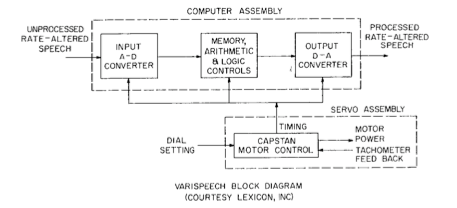When I was planning my “editorial calendar” for the next few weeks, I had planned on discussing the Eventide H910 Harmonizer as the “first digital pitch shifter.” I even described the H910 as such in an earlier blog post. However, it turns out I was wrong. The Lee article that I discussed in my previous post describes what is probably the first commercially available pitch shifter, the Lexicon Varispeech:
 The Lexicon Varispeech was introduced in 1972, a good 3 years before the H910. The Lexicon Pro website makes only passing mention of the device, describing it as a “Lexicon product for the language instruction market.” Fortunately, the Obsoletetechnology blog has a nice overview of the device, including photos, gutshots, and sound examples. The following image is taken directly from the aforementioned blog post, which you really should read:
The Lexicon Varispeech was introduced in 1972, a good 3 years before the H910. The Lexicon Pro website makes only passing mention of the device, describing it as a “Lexicon product for the language instruction market.” Fortunately, the Obsoletetechnology blog has a nice overview of the device, including photos, gutshots, and sound examples. The following image is taken directly from the aforementioned blog post, which you really should read:
Interestingly enough, for a device that was marketed as being used for speech and time compression, the Varispeech 27Y has a feedback knob. This is solely for use as a special effect, and was prominently featured on the H910 and H949 harmonizers of later years. I am uncertain if this was in the 1972 Varispeech, or if the 27Y was the original Lexicon model or a later version. If anyone has any info, please contact me.
Chris Walla of Death Cab for Cutie describes his use of the Lexicon Varispeech in an EQ Mag interview, where he also notes the incongruity of the feedback knob on a device used for time compression and expansion:
There was a lot of speech pathology research developed at Lexicon that was cross-purposed into pro audio. The Varispeech was originally intended to help stroke victims and people with speech disorders. The idea was that you could slow down a conversation at regular pitch but keep pitch where it was so that people could practice figuring out how to reconnect their mouth and their brain.
There was this weird period where [Lexicon was] screwing around with it; I got one that had a feedback knob, which as far as I can tell is completely useless for speech pathology, but it makes everything sound like Doctor Who, which is awesome.
It sounds great under the snare drum, and Tegan’s vocals run through it on ‘The Cure’ when she does the ‘Oh, uh oh, uh oh’ thing. The Varispeech is a really cool chorus-y, flange-y thing if you set it up that way. But it’s a speaker destroyer, too. It’s an old [’70s] effect, and Lexicon wasn’t worried about being sued by guys who were like, ‘You blew up my guitar amp, dude!’
I love those kinds of buttons, the clear button with an orange indicator that would open up underneath. Back when a mechanical switch was cheaper than putting in an LED.
Vintage digital, love it.
The Obsoletetechnology blog has pictures of the inside of the unit. There is almost nothing in there. Which is weird, as most early digital units are packed full of stuff. Which makes me think that the 27Y is a later unit, with a custom integrated circuit to do the heavy lifting.
I agree, that is one good looking piece of hardware. Those knobs would probably cost a fair amount of change nowadays.
ValhallaShimmer: a bit of history « The Halls of Valhalla
Hi Sean,
I just bought one of these weird Y-machines and I wonder if it fully working because it is really noisy; also when not when no signal is fed and teh feedback = 0 it produces noisy strucures.
Cheers,
C
If anyone has one to sell, id like to buy it!
Fell in love with it at a friends studio.
Send me a email =) spacebeach@live.com
I have a model 26 that I recently acquired, but I can find hardly any info on it..Does anybody know anything about this device?